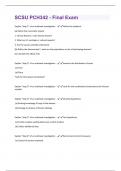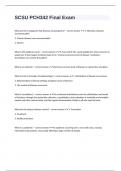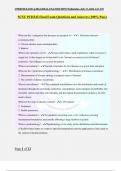Scsu pch342 - Study guides, Class notes & Summaries
Looking for the best study guides, study notes and summaries about Scsu pch342? On this page you'll find 5 study documents about Scsu pch342.
All 5 results
Sort by
SCSU PCH342 Final Exam correctly answered to pass

-
SCSU PCH342 - Final Exam Questions And Answers Rated A+
- Exam (elaborations) • 15 pages • 2024
- Available in package deal
-
- $7.99
- + learn more
Explain *step 1* of an outbreak investigation - Define the epidemic (a) Define the numerator (cases) 1. Clinical features: is the disease known? 2. What are it's serologic or cultural aspects? 3. Are the causes partially understood (b) Define the denominator": what are the populations at risk of developing disease? (c) Calculate the attack risks Explain *step 2* of an outbreak investigation - Examine the distribution of cases (a) Time (b) Place *look for time-place interactions* Exp...

-
SCSU PCH342 Final Exam | Questions with 100% Correct Solutions
- Exam (elaborations) • 17 pages • 2024
-
- $12.98
- + learn more
Explain the epidemiologic(al) triad - Answer It is a principle that is used in disease control. For a disease to occur, those 3 must be present (agent, host, and environment). If one can find a way to disrupt this relationship, you can disrupt the occurrence of disease; attack the weakest link What is an agent? - Answer Microorganisms responsible for inflicting us with diseases (bacteria, viruses, parasites)
SCSU PCH342 Final Exam Questions and Answers (100% Pass)
SCSU Full Package Deal With Latest Study Quizzes ( Questions And Answers) Complete Study Solutions

Did you know that on average a seller on Stuvia earns $82 per month selling study resources? Hmm, hint, hint. Discover all about earning on Stuvia





